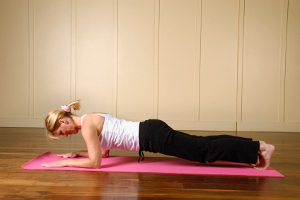How to Do Dolphin Plank in Yoga
 One of the most popular core-building exercises in yoga is Plank Pose, also known as High Push-Up Pose. Performing Plank with correct alignment, though, can be nearly impossible for those with wrist pain or carpal tunnel syndrome. This variation, called "Dolphin Plank," is done on the forearms, which takes the pressure off the wrists while providing all of the benefits of Plank Pose.
One of the most popular core-building exercises in yoga is Plank Pose, also known as High Push-Up Pose. Performing Plank with correct alignment, though, can be nearly impossible for those with wrist pain or carpal tunnel syndrome. This variation, called "Dolphin Plank," is done on the forearms, which takes the pressure off the wrists while providing all of the benefits of Plank Pose.
Plank Pose is a major component of Sun Salutations, which are performed several times during Ashtanga, Vinyasa, and Power Yoga classes. For those whose wrists are sore from sports, weight-lifting, computer work, or other repetitive activities, Dolphin Plank can be a great modification to any yoga class that includes Sun Salutations!
Benefits of Dolphin Plank
Dolphin Plank builds strength through resistance of your body's weight, which helps to increase bone density. This pose strengthens the arms, legs, and core muscles, including the abdomen, chest, and low back. It also strengthens the muscles around the spine, which helps to improve posture. In addition, Dolphin Plank stretches the shoulders, hamstrings, calves, and feet.
Yoga gave me the ability to calm down.
The concentrated effort required to hold Dolphin Plank calms the mind and regulates the nervous system — benefits that are also therapeutic for stress and mild depression. Practicing this pose for several minutes will build stamina, endurance, and focus.
Cautions
Do not practice Dolphin Plank if you have a recent or current shoulder, back, arm, or neck injury. Also avoid this pose if you have high blood pressure, or infections of the eye or inner ear. Always work within your own range of limits and abilities. If you have any medical concerns, talk with your doctor before practicing yoga.
Instructions
- Begin on your hands and knees. Align your wrists directly under your shoulders, and your knees under your hips. Lower your elbows to the floor directly beneath your shoulders. Keep your forearms parallel to each other and to the side edges of your mat. Distribute your weight evenly across both forearms. Breathe smoothly and evenly through your nose.
- Tuck your toes and step back with your feet, bringing your body and head into one straight line. Align your heels over your toes.
- Keep your thighs lifted and take care not to let your hips sink too low. If your butt sticks up in the air, realign your body so your shoulders are directly above your elbows.
- Contract your abdominals and draw your pelvic floor muscles toward your spine. Keep your head in line with your spine.
- Broaden across your shoulder blades and collarbone. Gaze between your hands, or toward the top edge of your mat.
- Press the front of your thighs (quadriceps) up toward the ceiling while lengthening your tailbone toward your heels.
- Hold the pose while breathing smoothly for five breaths. Advanced practitioners and those using the pose to build stamina can hold for up to five minutes. To release the pose, slowly lower onto your knees, then press back into Child's Pose (Balasana) and rest. Repeat up to 10 times.
Modifications & Variations
Dolphin Plank is a great modification for those with wrist pain and carpal tunnel syndrome — but it's also a challenging core strengthener in its own right! It can take some time to build up enough strength to hold the pose. Be sure to take it slowly and not over-stress your shoulders. Try these modifications to find a variation of the pose that works for you:
- If your core muscles or arms are not yet strong enough to support your full bodyweight, lower your knees to the floor (this is called Half Dolphin Plank). Be sure to keep your head and spine in a straight line.
- To deepen the pose, try lifting one leg at a time. Flex your foot and lift your heel toward the ceiling. Hold the lifted leg for five breaths. Then, repeat with the opposite leg for the same amount of time.
- To deepen the shoulder stretch, press your palms together with your forearms on the floor, or clasp all ten fingers together.
- For a greater challenge, press yourself from Dolphin Plank directly into Dolphin Pose. Then, come back into Dolphin Plank. Repeat 10-20 times (being careful not to over-strain your shoulders).
Tips
Dolphin Plank and regular Plank Pose will benefit the whole body when practiced in correct alignment! Keep the following information in mind when practicing Dolphin Plank:
- Do not allow your hips and butt to sag too low or poke too high — it's important to keep your body in one straight line, from shoulders to heels.
- Keep your shoulders aligned directly over your elbows.
- Keep the space between your shoulder blades wide while broadening across your collarbones. This action helps to prepare you for other arm balances, like Crow Pose (Bakasana).
Strong to the Core
Dolphin Plank can strengthen your core and shoulders fast! Practice the pose several times a day to tone your muscles and re-gain focus. Try holding Dolphin Plank for extended periods to build stamina, focus, and endurance. For extra variety, change up your regular Sun Salutations by practicing Dolphin Plank and Dolphin Pose instead of Plank Pose and Downward-Facing Dog. Think of those friendly bottle-nosed creatures, and have fun with the Dolphin variations!

